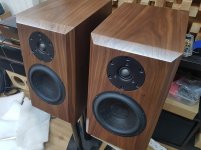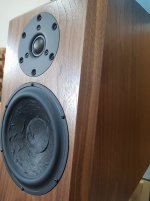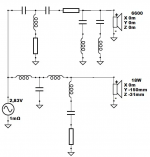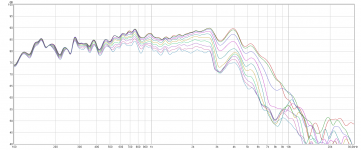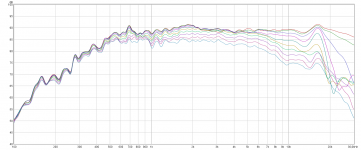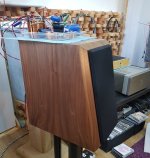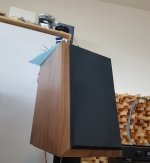After few larger, 3way projects, with Bliesma tweeters, I wanted to build something easier, smaller, yet still providing reasonable bass extension and sound quality. 18W/8545K00 and 6600 were already in house, on the shelf, and these drivers definitely deserve better then just staying in the boxes.
Woofer alignment modelling was the first action, also reading and studying 3rd party measurements and experiences. This driver model well in 15-30liters BR. This project was meant to be standmount 2way, so I wanted to keep volume on lower side. Moreover, few experiences told me larger volumes and trying to achieve as low extension as possible do not provide good subjective bass quality. So I ended up with 16liters enclosures.
18W Classics drivers are quite famous and already on the market for ages. Quite surprisingly, there is not much projects, measurements, experiences and sound descriptions on the internet. From datasheet FR it was clear they are not as linear as one would wish so I was prepared for the fact that crossover work would be more difficult here. Measurements confirmed that and I used acoustic LR4 slopes at 1650Hz to get geed off axis set of FRs and phase matching.
Initial crossover was little bit bright in 2-10kHz area, and I expected, based on 6600 measurements, that I will have pay more attention to this area and make adjustments by listening tests.
I have to say, after few adjustments and drivers burn-in, I am very happy with the sound. Bass quality, overall balance, details,...all is there and the sound is very much enjoyable.
Writeup and more details:
https://pkaudio.webnode.cz/classillu/
Woofer alignment modelling was the first action, also reading and studying 3rd party measurements and experiences. This driver model well in 15-30liters BR. This project was meant to be standmount 2way, so I wanted to keep volume on lower side. Moreover, few experiences told me larger volumes and trying to achieve as low extension as possible do not provide good subjective bass quality. So I ended up with 16liters enclosures.
18W Classics drivers are quite famous and already on the market for ages. Quite surprisingly, there is not much projects, measurements, experiences and sound descriptions on the internet. From datasheet FR it was clear they are not as linear as one would wish so I was prepared for the fact that crossover work would be more difficult here. Measurements confirmed that and I used acoustic LR4 slopes at 1650Hz to get geed off axis set of FRs and phase matching.
Initial crossover was little bit bright in 2-10kHz area, and I expected, based on 6600 measurements, that I will have pay more attention to this area and make adjustments by listening tests.
I have to say, after few adjustments and drivers burn-in, I am very happy with the sound. Bass quality, overall balance, details,...all is there and the sound is very much enjoyable.
Writeup and more details:
https://pkaudio.webnode.cz/classillu/
Attachments
Last edited:
I know that project. I know 6600 very well from my previous projects. My remark to not much info on the internet was for 18W Classics.
Thank you for the update. It’s nice to see polars of this driver. Is that really the horizontal measurements, on baffle, out to 90 degrees?
That’s quite remarkable response out to past 2KHz.
There was a lot of data on the internet for the classic 8545/K; but they’ve all expired (the web links; sometimes the people too)
Dan Wesnor’s Ella; Rick Craig’s, Dennis Murphy’s, Troels Gravesen, John Krevskovsky all had them in 2 and 3 ways.
It’s such an old driver. We’re talking pre YouTube, pre-social media, pre-Internet. You’d have to back to BBS…
…the development of the SD motor system was in 1973, with the paper cone 18W/8542 somewhere between 1987-1984. The poly cone (18W/8543) was introduced in 1987, 8544 (Kevlar) in 1988, carbon-paper 8545 and variants afterwards, and even later fibreglass (8546-01)
How old are your drive units?
I’ve always wondered they how the vintage ones compare to the current in production ones.
That’s quite remarkable response out to past 2KHz.
There was a lot of data on the internet for the classic 8545/K; but they’ve all expired (the web links; sometimes the people too)
Dan Wesnor’s Ella; Rick Craig’s, Dennis Murphy’s, Troels Gravesen, John Krevskovsky all had them in 2 and 3 ways.
It’s such an old driver. We’re talking pre YouTube, pre-social media, pre-Internet. You’d have to back to BBS…
…the development of the SD motor system was in 1973, with the paper cone 18W/8542 somewhere between 1987-1984. The poly cone (18W/8543) was introduced in 1987, 8544 (Kevlar) in 1988, carbon-paper 8545 and variants afterwards, and even later fibreglass (8546-01)
How old are your drive units?
I’ve always wondered they how the vintage ones compare to the current in production ones.
Last edited:
Yes, all measurements on actual baffle. I will do full H and V 0-180deg measurement + distortion measurement on a finished loudspeaker in coming weeks.
My units are ~1year old.
When I saw the measurements, and now listening to these drivers, I am glad they are still on a market. 18W classic hits the right balance of sound quality, good measurements, volume requirements vs bass extension, interesting look (though likely not to everyone's liking) for 2way loudspeaker.
There is a lot options for 6" midwoofer for 2way, but.....:
18WU - excellent, though expensive, this would be improvement in all areas....bass extension, transparency, detail, though >20liters would be required
18W revelator, requires larger volume, and from my experiences, I am not fully convinced it would provide significant improvement over Classics. what I recall from Ekta Grande upgrade, these revelators seem to have softer presentation compared to 18W
Purifi: well, a lot expensive, plus Pasive radiators as port would be likely too long (a lot of troubles)
MW16, MW19: I know both very well, I like Scan Speaks better
SB17: no no no
Seas: either too expensive, or mediocre performance, sometimes even both together
Vifa NE180W: this would be really something, but availability is an issue here
WF180BD09/10: this could be very good, no objections
And at least Timothy's measurements of 18W.
http://feleppa.com.au/speakermeaswoofer.html
My units are ~1year old.
When I saw the measurements, and now listening to these drivers, I am glad they are still on a market. 18W classic hits the right balance of sound quality, good measurements, volume requirements vs bass extension, interesting look (though likely not to everyone's liking) for 2way loudspeaker.
There is a lot options for 6" midwoofer for 2way, but.....:
18WU - excellent, though expensive, this would be improvement in all areas....bass extension, transparency, detail, though >20liters would be required
18W revelator, requires larger volume, and from my experiences, I am not fully convinced it would provide significant improvement over Classics. what I recall from Ekta Grande upgrade, these revelators seem to have softer presentation compared to 18W
Purifi: well, a lot expensive, plus Pasive radiators as port would be likely too long (a lot of troubles)
MW16, MW19: I know both very well, I like Scan Speaks better
SB17: no no no
Seas: either too expensive, or mediocre performance, sometimes even both together
Vifa NE180W: this would be really something, but availability is an issue here
WF180BD09/10: this could be very good, no objections
And at least Timothy's measurements of 18W.
http://feleppa.com.au/speakermeaswoofer.html
This project was meant to be quite simple.
Regarding facets, they are effective though they have to be large, similarly to roundovers.
There is Heissmann study of facets, few years back I used large facets with dxt tweeter, it resulted in perfect mearument results.
If I decide for more baffle complexity I prefer roundovers, I prefer that esthetics.
Regarding facets, they are effective though they have to be large, similarly to roundovers.
There is Heissmann study of facets, few years back I used large facets with dxt tweeter, it resulted in perfect mearument results.
If I decide for more baffle complexity I prefer roundovers, I prefer that esthetics.
Last edited:
thanks for the project documentation, very good looking speakers!
... your website is a great resource of information and inspiration!Writeup and more details:
https://pkaudio.webnode.cz/classillu/
stv: thank you, I am always pleased to read people visit and like my website.
system7: good question. I am 90% decided to make this project fully documented, supported, and with paid construction plans. From time to time a get requests for some of the projects, so I wanted to make something new, quite simple, high sound quality, with all measurements.
system7: good question. I am 90% decided to make this project fully documented, supported, and with paid construction plans. From time to time a get requests for some of the projects, so I wanted to make something new, quite simple, high sound quality, with all measurements.
Pida - can you talk a bit about the acoustical damping material you used, and how it was placed in the cabinet? I have found that small vented box 2-ways are challenging to get the damping just right. Too much stuffing and the bass becomes weak, with not enough punch. Too little stuffing and the midrange becomes congested and forward... it seems hard to get a good balance... what are your thoughts on this?
Jim, some box simulators allow you to model an arbitrary amount of damping, so you can design for a bass response in spite of there being a certain amount of it. I understand you wanting enough of it there to manage your box modes, and rightly so.
I used to think BR boxes were not supposed to have much stuffing in the eclosures. After few experiments and experiences with various projects I started to use more stuffing. I use felt material on the walls and material similar to monacor mdm2 and 3. I still keep stuffing not so much close to driver, and arranged in the way that port can clearly see the driver.
Too much stuffing and bass gets weak, on the other hand midrange becomes cleaner, so it is about finding the balance. Too little, and bass loses definition and midrange loses detail.
Sims are one thing, but hearing how it actually sounds and experimenting is next step.
Port is on the rear side in upper part of eclosure, so I put stuffing behind the driver and around the port. So ~3/4 of enclosure, the rear side, is filled with stuffing.
Too much stuffing and bass gets weak, on the other hand midrange becomes cleaner, so it is about finding the balance. Too little, and bass loses definition and midrange loses detail.
Sims are one thing, but hearing how it actually sounds and experimenting is next step.
Port is on the rear side in upper part of eclosure, so I put stuffing behind the driver and around the port. So ~3/4 of enclosure, the rear side, is filled with stuffing.
motokok: thank you
Baffle tilt is set to approximatelly align acoustic centers of the drivers. It does no make much sense to try to align precisely, for most of 6" midwoofers acoustic center is ~20-30mm behind front baffle => so baffle tilt ~25mm is good initial point. Final crossover tuning, crossover Frequency, exact slopes,....it all is flexible within reasonable range.
Of course, ideally one would make test baffles first, measure, design crossover, find ideal tilt, make another cabinets, measure again etc so it would be itterative process, but it is very time and cost consuming. So after few experiences I somehow predict the result based on initial conditions like tilt, drivers arrangement etc.
I do not like "everything can be corrected in the crossover" approach.
Baffle tilt is set to approximatelly align acoustic centers of the drivers. It does no make much sense to try to align precisely, for most of 6" midwoofers acoustic center is ~20-30mm behind front baffle => so baffle tilt ~25mm is good initial point. Final crossover tuning, crossover Frequency, exact slopes,....it all is flexible within reasonable range.
Of course, ideally one would make test baffles first, measure, design crossover, find ideal tilt, make another cabinets, measure again etc so it would be itterative process, but it is very time and cost consuming. So after few experiences I somehow predict the result based on initial conditions like tilt, drivers arrangement etc.
I do not like "everything can be corrected in the crossover" approach.
Just few thoughts on 18W/8545K00 and Scan Speak Classic drivers generally. It has been ~6months since I sold this project, and the friend of mine who bought it liked them a lot and likes even more.
At the beginning of the project, based on reading of other projects using those 18W drivers and seeing measurements, I was little bit afraid of too warm sound and FR irregularities ~1kHz. Often I saw quite simple filters with Fc >2kHz and rather higher even 3kHz. I think the opinions on the sound are based on this higher Fc and FR dip (and this dip is consistent also off axis) the driver has its inherent warm sound character.
After doing my measurements I tried to come with crossover that could mitigate the dip ~1200Hz, push it up by ~2dB, and make the response more linear. This required higher Q crossover. I tried LR2 + RLC below 1Khz and various values and configurations, nothing led to the FR I would like. So 3rd order electrical, and after seeing this was the right direction I did fine tuning and was able to come with the topology that was simple enough and yet provided required linearized response. 18W off axis response is very consistent so it was not too difficult to match it to 6600 and come with nice off axis responses set, at least considering this is simple 6"+"1" combo.
8545K00 does the bass in 16l ported very well, it is not 18W revelator or 18WU bass in 30l ported (often mentioned as quite a reference, though I do not like it, ~25l sounds better, tighter bass and cleaner midrange), it is actually even better, firm and detailed, lower midrange and midrange is also very good, and I see this driver as well balanced for 2way midwoofer duty. If I have to compare it so something generally known, then Satori MW16P and MW19P, I prefer 18W more, lot more. It does the bass much cleaner, midrange quality is not far behind bass quality.
I wish Scan Speak revisited 18W Classic drivers, removed the dust cap and replaced it with phase plug. This could be the step in the right direction.
At the beginning of the project, based on reading of other projects using those 18W drivers and seeing measurements, I was little bit afraid of too warm sound and FR irregularities ~1kHz. Often I saw quite simple filters with Fc >2kHz and rather higher even 3kHz. I think the opinions on the sound are based on this higher Fc and FR dip (and this dip is consistent also off axis) the driver has its inherent warm sound character.
After doing my measurements I tried to come with crossover that could mitigate the dip ~1200Hz, push it up by ~2dB, and make the response more linear. This required higher Q crossover. I tried LR2 + RLC below 1Khz and various values and configurations, nothing led to the FR I would like. So 3rd order electrical, and after seeing this was the right direction I did fine tuning and was able to come with the topology that was simple enough and yet provided required linearized response. 18W off axis response is very consistent so it was not too difficult to match it to 6600 and come with nice off axis responses set, at least considering this is simple 6"+"1" combo.
8545K00 does the bass in 16l ported very well, it is not 18W revelator or 18WU bass in 30l ported (often mentioned as quite a reference, though I do not like it, ~25l sounds better, tighter bass and cleaner midrange), it is actually even better, firm and detailed, lower midrange and midrange is also very good, and I see this driver as well balanced for 2way midwoofer duty. If I have to compare it so something generally known, then Satori MW16P and MW19P, I prefer 18W more, lot more. It does the bass much cleaner, midrange quality is not far behind bass quality.
I wish Scan Speak revisited 18W Classic drivers, removed the dust cap and replaced it with phase plug. This could be the step in the right direction.
Last edited:
Funny you should say that. Usher did that, with their 8945P. And that was a stellar driver. Too bad it became NLA some years ago... a favorite with @capslock , and a few others too, if I recall correctly.

http://www.zaphaudio.com/6.5test/
A couple of decades ago is was available for about $100. How times have changed.
If Scan-Speak released it with optimized surround-cone edge, and optimized dust cap/phase plugs, I wonder if there the other line of drivers might get jealous. 😉
http://www.zaphaudio.com/6.5test/
A couple of decades ago is was available for about $100. How times have changed.
If Scan-Speak released it with optimized surround-cone edge, and optimized dust cap/phase plugs, I wonder if there the other line of drivers might get jealous. 😉
I remember this Usher driver from my DIY beginnings.
I think there were Scan Speak OEM versions with improved linearity and small design changes. For example Xavian Virtuosa used Classic driver with phase plug.
I think there were Scan Speak OEM versions with improved linearity and small design changes. For example Xavian Virtuosa used Classic driver with phase plug.
Magnetic grills finished.
can you give some details about that? the baffles in post 1 show no clues
- Home
- Loudspeakers
- Multi-Way
- ClassIllu - Scan Speak 2way, tilted baffle
